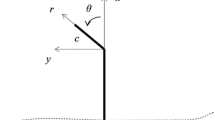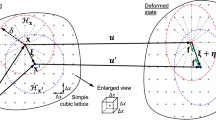Abstract
This study concerns the fracture of rubbers. The objective is to verify the validity of the J-integral expression we proposed for such materials (Aït Hocine et al., 2002). In this expression, the parameter J is represented as a multiplicative form of a geometrical η* (or η) factor and elastic work per unit area as it has been already done in the Linear Elastic Fracture Mechanics (LEFM) (Turner, 1973). The whole problem rests in the fact that the factor η* (or η) is unknown whereas in LEFM, expressions of ηel factors are available for several kinds of specimen geometry. Thus, in this work, an experimental and a numerical analysis have been achieved and we have shown, for both the studied materials and the considered specimens, that these unknown factors could be replaced by those issued from the LEFM or from the work of Kim and Joe (1989) on rubber-like materials. The results obtained confirm the validity of our model representing a single specimen method of an experimental evaluation of the elastomers fracture energy.
Similar content being viewed by others
References
Aït Hocine, N., Naït Abdelaziz, M. and Imad, A. (2002). Fracture problems of rubbers: J-integral estimation based upon η factors and an investigation on the strain energy density distribution as a local criterion. International Journal of Fracture 117, 1-23.
Aït Hocine, N., Naït Abdelaziz, M. and Mesmacque, G. (1998). Experimental and numerical investigation on single specimen methods of determination of J in rubber materials. International Journal of Fracture 94, 321-338.
Aït Hocine, N., Naït Abdelaziz, M., Ghfiri, H. and Mesmacque, G. (1996). Evaluation of the energy parameter J on rubber-like materials: a comparison between experimental and numerical results. Engineering Fracture Mechanics 55(6), 919-933.
Andrews, E.H. (1974). A generalised theory of fracture mechanics. Journal of Materials Sciences 9, 887-894.
Andrews, E.H. and Billington, E.W. (1974). A generalised theory of fracture mechanics-part 2: Materials subject to general yielding. Journal of Materials Sciences 10, 1354-1361.
Benthem, J.P. and Koiter, W.T. (1972). Asymptotic approximations to crack problems-Method of analysis and solutions of crack problems. Mechanics of Fracture 1 (Edited by G.C. Sih), Noordhoff International Publication, Leiden, p. 157.
Griffith, A.A. (1920). Phil. Trans. Soc. London A221, 163.
Hellen, T.K. (1989). Virtual crack extension method for non-linear materials. International Journal for Numerical Methods in Engineering 28, 929-942.
Kim, B.H. and Joe, C.R. (1 89). Single specimen test for determining fracture energy (Jc) of highly deformable materials. Engineering Fracture Mechanics 32, 155-161.
Mooney, M. (1940). A theory of large elastic deformation. Journal of Applied Physics 11, 582-592.
Oden, J.T. (1972). Finite Elements of Non-Linear Continua, McGraw-Hill Book Company, New York.
Paris, P.C., Ernst, H., and Turner, C.E. (1980). A J integral approach to development η factors. ASTM STP 700, 338-351.
Rice, J.R. (1968). In: Mathematical Analysis in the Mechanics of Fracture, Vol. 2 (Edited by H. Liebowitz), Academic Pres, London, 191-311.
Rivlin, R.S. and Thomas, A.G. (1953). Rupture of rubbers: I characteristic energy for tearing. Journal of Polymer Sciences 10, 291-318.
Rooke, D.P. and Cartwright, D.J. (1976). Compodium of Stress Intensity Factors, Hillington Press, London.
Sharobeam, M.H. and Landes, J.D. (1991). The load separation criterion and methodology in ductile fracture mechanics. International Journal of Fracture 47, 81-104.
Sumpter, J.D.G. and Turner, C.E. (1976). Method for Laboratory Determination of J c. ASTM STP 601, 3-18.
Thomas, A.G. (1955). Rupture of rubbers: II the strain concentration at an incision. Journal of Polymer Sciences 18, 177-188.
Turner, C.E. (1973). Material Science Engineering 11, 275-282.
Turner, C.E. (1980). The ubiquitous η factor. ASTM STP 700, 314-337.
Author information
Authors and Affiliations
Corresponding author
Rights and permissions
About this article
Cite this article
Hocine, N.A., Abdelaziz, M.N. A new alternative method to evaluate the J-integral in the case of elastomers. International Journal of Fracture 124, 79–92 (2003). https://doi.org/10.1023/B:FRAC.0000009301.54681.ae
Issue Date:
DOI: https://doi.org/10.1023/B:FRAC.0000009301.54681.ae




